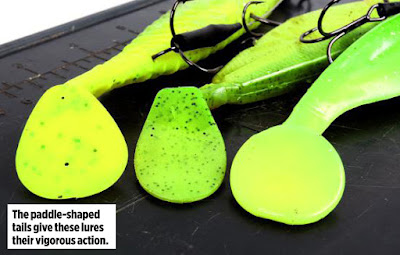While all lure fishing is exciting, hunting pike with artificial baits has to be one of the best methods, just because it is a very efficient way of catching big fish from a variety of venues. On canals, fast flowing rivers, gravel pits or giant reservoirs, soft plastics will catch pike, and rather than play second fiddle to deadbaits, lures can often outscore the real thing.
 |
| Fox Rage Pro Shad FireTails II |
Most need rigging yourself, adding a weighted jig head and maybe a stinger hook rigged behind it to hook more fish. Rigging the lures yourself offers flexibility, as you can change the weight and the position of the hooks to suit the venue.
 |
| Westin Pro Stinger Double |
Lure Choice Made Easy
There are thousands of different lures on the market, so how do you know which ones are right for you? Fortunately, with soft plastics, you can easily and quickly narrow the choice down.
 |
| Paddle Tails Create An Enticing Action |
Ninety percent of the soft lures used by some of the top pike anglers have a paddle tail that imparts plenty of action in the water. Other styles are for zander and perch.
 |
| Carry Different Colours of Soft Plastics |
 |
| Fox Rage Round Jig Head |
What Weight of Jig Head Do you Add?
Grubs and shads can be quite heavy, but in water they are neutrally buoyant and need a weighted jig head to get them down to the right depth.
The rule of thumb is to use one gram per foot of water. So if you want the lure to run at 5ft, use a 5g jig head. For 15ft, increase this to 15g (and so on).
 |
| 15g For 15ft of Water |
If you are new to using soft plastic lures, Berkley, Fox Rage, and Savage Gear all offer them pre-rigged with a jig hook and stinger treble already fitted.
 |
| Savage Gear 4D Line Thru Pike |
 |
| How To Rig Soft Plastics |
When it comes to lure colour, there are differing opinions. Some very successful pike anglers place little emphasis in lure colour. However, using different colours of the same pattern, there is plenty of evidence to suggest that it does make a significant difference, especially where the water is clear.
You have to be careful not to pick colours just because you like them. Pike perceive colour entirely differently to humans, and often it is the not-so-obvious patterns that can work best.
Greens and yellows are the main go-to colours for many top pike anglers. Everything from super-bright chartreuse to drab olive will catch pike, and this end of the spectrum attracts them. The brighter colours often produce the most fish, especially on venues that have not seen a lot of lure fishing. The nondescript dark greens have an uncanny knack of turning up the bigger fish and also work well in murky water, even at night.
A lot of top pike anglers achieve excellent success lure fishing before dawn, and it is the strong silhouette of a dark green lure that produces the goods time after time.
This article was brought to you in association with Angling Times.

Comments
Post a Comment